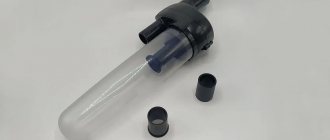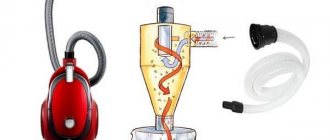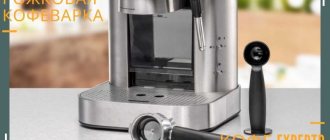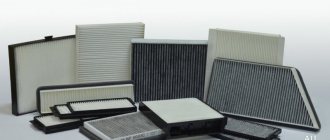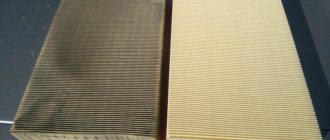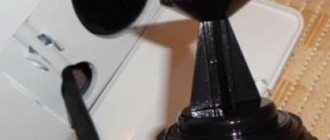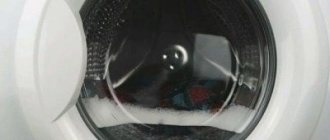Modern vacuum cleaners are equipped with a multi-level filtration system. This greatly improves the quality of the tidy. A HEPA filter is used for fine air purification; it stands at the last line between dust and the environment. This is an effective element. The abbreviation HEPA stands for High Efficiency Particulate Absorption, which in English means “highly effective dust retention.” Manufacturers of modern high-quality vacuum cleaners use technologies that provide different air filtration systems. This article describes the principle of operation of a HEPA filter, its main purpose, types and instructions for proper use.
First of all, you need to understand the types. The Nera filter for a vacuum cleaner can be disposable - based on paper with an admixture of fiberglass, and reusable when it is possible to wash with water (made from fluoroplastic fibers).
Capabilities of hepa filters
A high-quality vacuum cleaner should have such a cleaning system. To create the least resistance to air flow, the device must have the largest filtered area at its disposal. To achieve this result, it is made from a material that can be folded like an accordion and glued into the largest frame.
The small-sized Nera filter has a small cleaning area and quickly becomes clogged with debris, as a result of which it interferes with the air flow, and this reduces the suction power of the vacuum cleaner, which leads to its overheating.
Tandem AQUA and HEPA
As a result of the humidification of the air in the water purification system, the HEPA becomes covered with a large amount of dirt.
A humid environment leads to the fact that various bacteria, fungi and mold begin to actively multiply on it.
If it is not changed at the time specified in the passport, then instead of purifying the air, it will turn into a breeding ground for microorganisms , which will intensively saturate the apartment during cleaning.
Therefore, in devices with a water cleaning system, it is necessary to especially carefully monitor the expiration dates of HEPA and replace it in a timely manner.
What does a HEPA filter eliminate?
It is used to purify the air from small particles, the size of which is 0.1–1.0 microns. Microfibers trap such particles using certain mechanisms:
- Interception effect. Particles of any size passing near the microfibers cling to them and remain on the filter or are held by particles already attached to the filter.
- Inertial effect (impact). Retention of large particles that have high inertia and move with air flow until they come into contact with the barrier.
- Diffusion effect. Air filtration from the smallest particles, the size of which is 0.01–0.1 microns. They constantly bump into air molecules, because of this they begin to move chaotically to the sides of the air flow line. Such curvilinear motion maneuvers increase the likelihood of the particle stopping due to the mechanisms described above.
This effect dominates when operating at low speed and low air flow, a clear example of this technique is an air purifier with a Nera filter.
Division into classes
The Nera filter for the vacuum cleaner produces fine cleaning. The effectiveness of fine filters is determined by tests in the laboratory based on the percentage of microparticles stopped. To carry out tests in laboratory conditions, aerosols are used, which contain synthetic microparticles 0.3 microns in size. Fine filters are divided into classes according to EN 1822/DIN 24183:
- HEPA 14 - 0.3 micron particle, 99.995% delay;
- HEPA 13 - 0.3 micron particle, 99.95% delay;
- HEPA 12 - 0.3 micron particle, 99.5% delay;
- HEPA 11 - 0.3 micron particle, 95% delay;
- HEPA 10 - 0.3 micron particle, 85% delay.
Vacuum cleaners
Externally, microfilters resemble dense pieces of thick felt, non-woven fabric or padding polyester. They differ from each other in dust retention efficiency and service life, the presence or absence of a frame and seals. Some of them are washable, i.e. reusable. There is no need to purchase them regularly, but the efficiency of air purification is not too great. They are capable of trapping about 80-90% of particles larger than 0.3 microns. Disposable microfilters provide more effective cleaning. It is generally recommended that they be replaced at the same time as every fifth paper dust bag replacement. S-class filters and HEPA filters usually look like paper “accordions” of complex shape. This increases the effective filter surface. They are necessarily equipped with a rigid frame with a seal. Such a filter must be tightly installed in its place in order to completely eliminate the possibility of air passing around it (through the cracks). HEPA filters provide the highest efficiency in removing the smallest particles and allergens. The service life of such filters ranges from one year (about 50 hours of operation of the vacuum cleaner) to several years if the filter can be washed under water. (The degree of air purification with a HEPA filter is determined by international standards DIN 24184 and EN 1822).
MICROFILTER
The microfilter is usually made from electrostatically charged microfiber cellulose or polypropylene. It traps household dust particles up to 0.5 microns in size.
HEPA FILTER
A HEPA filter is usually made of synthetic fiber with very small pores. It traps household dust particles up to 0.06 microns in size.
| MICROFILTER HEPA FILTER |
An S-class filter is a filter that provides a filtration efficiency of at least 99.97% of particles larger than 0.3 microns (according to DIN 24184 standard).
HEPA filters differ in the degree of air purification (HEPA10, HEPA11, HEPA 12, HEPA13). Without a numerical designation that determines the class of a HEPA filter, it is impossible to judge its effectiveness. The HEPA H10 filter removes at least 85% of particles larger than 0.06 microns (according to EN 1822 standard). HEPA H11 filter - no less than 95%. HEPA H12 filter - no less than 99.5%. HEPA H13 filter - no less than 99.95%. It is believed that the cleaning efficiency of an S-class filter lies somewhere between a HEPA H11 and HEPA H12 filter. Vacuum cleaners with HEPA H14 class filters are expected to appear soon, with a filtration efficiency of at least 99.995% of particles larger than 0.06 microns. However, a correct comparison cannot be made, since filters with the letter designation Q-class, K-class, S-class are classified according to the degree of filtration of particles larger than 0.3 microns, while HEPA filters with a numerical designation are classified according to the degree of filtration of particles larger than 0 .06 microns, that is, the particle sizes retained by the filters differ by an order of magnitude. Formula for success
The quality of air purification with a vacuum cleaner directly depends on the correct selection of filters at each stage of air filtration. If at any stage you install a filter that is too coarse, it will allow a lot of dust to pass through, which will quickly clog the pores of the next filter. This will lead to a rapid decrease in suction power and the need to frequently replace a dirty filter (often expensive). A filter that will ideally cleanse the air of all contaminants will not allow air to pass through it easily, which will lead to a sharp drop in the power of the vacuum cleaner, and you simply will not be able to vacuum normally. The problem of selecting filters inside a vacuum cleaner, which is quite complex at first glance, has a simple solution. The better the air is cleaned at the first stage, the easier it will be for all subsequent filters to work, the power of the vacuum cleaner will remain constant longer, and the time between filter replacements will increase.
Paper vs fabric
Now it becomes clear why dust collectors are a very important part of the filtration system of vacuum cleaners. At the same time, despite the apparent simplicity of a disposable bag, its design can be quite complex: two-layer and multi-layer, because it must solve two problems that are in conflict with one another - to ensure effective air purification and not to weaken the suction power of the vacuum cleaner too much. The difference between different dust collectors is manifested primarily in the level of dust filtration (95-99% of particles larger than 1 micron). The simplest disposable dust bags are made from one or two layers of unbleached, uniform filter paper. High demands are placed on the strength of disposable dust collectors. It must be securely taped. The material from which the dust collector is made must have a homogeneous structure and withstand high pressure. The shape of the dust container must match the shape of the compartment in which it is located in the vacuum cleaner. The connection with the exhaust pipe must be tight, it is desirable to have elastic rubber seals, and the cardboard front part of the dust collector must be rigid and not deformable in order to eliminate the appearance of any cracks through which dirt and dust can enter the vacuum cleaner, bypassing the dust collector. In recent years, dust collectors have appeared made from various synthetic materials with up to five layers. The inner layers may have a structure different from the outer layers, and the layers may differ in their ability to filter particles of different sizes. Although vacuum cleaners are still often equipped with reusable fabric dust collectors, this dust collector cannot be called anything other than a relic of the past. It has too many disadvantages: a noticeably lower degree of filtration, an extremely unhygienic procedure for cleaning the bag, a noticeable drop in the suction power of the vacuum cleaner when reusing a fabric dust collector, the inevitable penetration of dust into the motor filter after reinstallation, etc. In addition, the worse the level of cleaning of the dust collector , the sooner you'll have to replace the motor or exhaust filter (another reason to avoid using a cloth dust bag). Trying to save money will result in faster replacement of an expensive engine or exhaust filter. The second reason to buy a better dust collector is that using them reduces the suction power of the vacuum cleaner. This is ensured by the use of a multilayer structure, in which each subsequent layer retains particles of a smaller size, which avoids the rapid clogging of the pores of the dust collector with dust, as happens with double-layer bags. On average, about 98% of contaminants remain in a paper dust collector.
Features of dust collectors
Any vacuum cleaner manufacturer offers standard disposable bags. Vacuum cleaner manufacturers themselves rarely produce disposable dust collectors. An exception to this rule is the Electrolux concern. The concern's plant in Sweden produces dust collectors for Electrolux vacuum cleaners, including 4 models of the s-bag family, as well as dust collectors under the Menalux brand. Production is certified according to ISO9002 standard. The use of the concern's testing laboratories and careful monitoring of all stages of the technological process and products guarantees the high quality of dust collectors of these brands. The production of disposable bags is usually carried out by specialized companies: Aichner Filter GmbH (trademarks Euro Plus and Top House), Melitta GmbH (trademarks Swirl, Swirl MicroPor and Swirl MicroPor Powerfilter), Worwo Sp. z oo (Worwo trademark), Russian (ECOLUX trademark) and Vesta Filter (Vesta-filter trademark). These companies have dust collectors for a large number of models of vacuum cleaners from different manufacturers. To make it easy to match the dust collector to the desired vacuum cleaner model, I developed informative packaging with a photo of the vacuum cleaner and clear labeling: Bosch - BS 02, Electrolux - EX 01, Samsung - SM 09, etc. Introduces a convenient light marking system and Menalux. Two large manufacturers: Electrolux and Philips have developed a unified standard - S-Bag. Currently, most Electrolux, Philips, AEG vacuum cleaners are equipped with just such dust collectors. Manufacturers of dust collectors, in an effort to improve the quality of air purification, produce improved modifications along with standard disposable bags. Improvements mainly come in three directions: improving filtration quality, reducing resistance to passing air and improving a variety of hygienic indicators. Improving the quality of filtration is usually achieved by increasing the number of layers of material from which the dust collector is made and using new materials. Three-layer dust bags are usually specifically labeled Mega filt (Bosch and Siemens), IntensiveClean (Miele), Purefilt (Hoover), Menalux Duraflow, s-bag E202 Clinic (Electrolux, Philips), Swirl MicroPor (made from multi-layer non-woven synthetic material Micropor), a number of models Euro Plus (made of micromelt synthetic material), Ecolux MultiMax (made of microfiber, special synthetic microfiber). Menalux is also converting 90% of its range to the new Duraflow synthetic material. There are a number of dust collectors whose filtration ability is confirmed by testing according to the EN 1822 method. Thus, the PureHepa dust collector used in Hoover vacuum cleaners meets HEPA H12 standards. Some manufacturers provide their own test results. Melitta guarantees filtration of 99.75% of all particles larger than 0.3 microns for its Swirl MicroPor dust collectors. Manufacturers pay more attention to hygienic parameters in the manufacture of dust collectors. Some dust collectors, for example Euro Plus S 4022 micro, Euro Plus M 309 micro, are impregnated from the inside with a special bactericidal composition, which does not allow bacteria trapped inside to survive. Some models of dust collectors absorb odors thanks to the use of activated carbon (Electolux E203 Anti-Odour for Electrolux, Philips, Swirl MIcroPor Powerfilter from Melitta). These dust collectors are generally recommended for pet owners. Note that activated carbon is often used at other stages of air purification in a vacuum cleaner, for example, in a motor filter (Bosch, Hoover, Electolux). For patients with asthma or allergies, special dust bags with an automatic shutter (hygienic valve) that tightly closes the inlet when the bag is removed from the vacuum cleaner may be relevant. This is convenient when replacing the dust collector; it does not generate dust at all. Dust collectors made of micromaterials are almost always equipped with this device. Almost every major manufacturer has such bags in their arsenal: PureHepa (Hoover), IntensiveClean (Miele), Swirl MicroPor and Swirl MIcroPor Powerfilter. Most dust collectors for Miele vacuum cleaners are manufactured by the Melitta concern. An article about dust collectors would not be complete without mentioning the Menalux SOS-Bag dust collector. This universal disposable dust bag fits any size and brand of vacuum cleaner and will help you out while you're looking for original bags. The neck of the bag is simply glued to an old cardboard holder, and with the help of this simple adapter design, the bag can be installed in any vacuum cleaner. In the next issues of the magazine, we will talk about what you need to retrofit your vacuum cleaner to solve specific (albeit quite common) tasks - picking up animal hair, cleaning carpets and rugs, washing windows, cleaning parquet and furniture, and we will also touch on the general rules for cleaning, the implementation of which will not allow the dust to settle again in its original place: on furniture, floor or sofa.
Purpose of a HEPA filter
It consists in the fact that it cleans the air of dust. This filter is different from the usual one because it is placed instead of a barrier at the exit of the air flow from the vacuum cleaner, and not at its inlet. Thus, this system is the last point of air purification from the smallest dust particles. These can be different types of allergens, insects, pet hair and other small elements.
Using a HEPA filter, you can almost completely remove the dust that flies everywhere during the cleaning process. In some cases, such cleaning is simply necessary. For example, a fine filtration system is required in rooms where there are people suffering from allergic diseases.
Marie Kondo's cleaning method
An important stage of any spring cleaning is throwing away unnecessary things. Chipped dishes, worn out towels, torn bags, mismatched socks, empty tubes of cosmetics - all this “good” belongs in a landfill.
The KonMari system, developed by the Japanese Marie Kondo, has become a fashionable way to clean up the house. The author of the technique gives mystical symbolism to things, assuring that a person’s bad or good memories arise after visual contact with a particular piece of furniture.
The general cleaning algorithm “Japanese style” is divided into 2 stages:
- Getting rid of things that don't bring you joy.
- Distribution of other things in the freed space.
Despite its apparent simplicity, the method works and has found many followers in Russia. KonMari cleaning is not divided into individual rooms, but into categories:
- cloth;
- Books and magazines;
- documentation;
- miscellaneous.
The principle of sorting is simple: if something makes you happy, we keep it; if it doesn’t, we throw it away. When everything unnecessary is sent to the landfill, Marie suggests distributing the remaining items for storage. The method of vertical placement of things may seem unusual to many at first, but then they appreciate the degree of convenience. The magic of cleaning in Japanese brings harmony and more order to family life.
What is harmful to a HEPA filter?
The service life of any device is affected by proper operation. The air filter best captures particles from 0.1 to 1.0 microns; it will not be able to catch smaller ones. Larger debris can adversely affect the performance of both the filter itself and the vacuum cleaner. The retained small particles constantly knock down larger ones, and this reduces the filtration efficiency. Large debris clogs the channels very quickly, which increases resistance to air flow. This can lead to overheating of the vacuum cleaner motor and damage. Therefore, particles that are not suitable for fine filters according to calculations, namely more than 1.0 microns, should not enter the device. As a rule, consumers do not have to think about this issue, since to prevent this from happening, modern vacuum cleaners have a multi-level air purification system.
HEPA bag is the best option
The best option for using such cleaning systems is a bag dust collector. All that remains is to find out which material is most beneficial: fabric, paper or synthetics.
- Fabric – traps debris particles up to 2 microns in size. This bag is completely incompatible with a HEPA filter.
- Paper – holds smaller particles than fabric, but they are prone to unexpected tears inside the appliance. This leads to immediate failure of the HEPA filter.
- Synthetics – capable of capturing particles with sizes ranging from 0.3 microns and above. In terms of cleaning quality, such a dust collector can be equated to a class 10 HEPA filter.
The tandem SYNTHETICS - HEPA is by far the most optimal.
If you are interested in filters for a specific manufacturer, then here you can find out all the necessary information about filters for devices from Samsung, and here - for vacuum cleaners from Thomas.
Scope of application
For the first time, HEPA filters began to be used in the West for high-quality cleaning of medical institutions. Afterwards they began to be used in modern household appliances, where they are still used today. Purifiers with a HEPA filter use:
- in pharmaceutical and medical institutions;
- in the electronics manufacturing industry, where equipment rooms need to be cleaned;
- for air filtration in hotels and inns;
- in the aerospace industry and mechanical engineering;
- at food enterprises;
- for cleaning radioactive aerosols at nuclear power plants;
- and, naturally, in household vacuum cleaners.
HEPA filter service life
The new HEPA filter is capable of capturing microparticles (from n10 to n14), but only until they stick to the filter fibers. Long-term operation depends on the area of the room being cleaned, on the frequency of use of the device, and on the size of the cleaning device. So what will the job be like if there are dust particles stuck to all the places on the filter fibers?
Subsequently, particles of debris entering the filter cling to each other and stick together. This process continues until the adhering particles reach a critical mass. Then these lumps break away from the filter fibers and, flying away, collide with other accumulated dust particles, tearing them off. This action resembles an avalanche. Based on the results of operation, a filter that works longer than the period suggested by the manufacturer retains dust much worse than the manufacturer indicated. It begins to poorly retain particles passing with the air flow. If you vacuum with a clogged HEPA filter, a strong smell of dust appears.
To fix this problem, you first need to try to clean the dirty accessory, wash it under running water (in the case of reusable models) or replace it with a new one. The service life is always indicated in the instructions for the vacuum cleaner.
What power should you pay attention to?
First of all, decide for yourself what purpose the vacuum cleaner will be used for. For apartments or houses with frequent renovations or a lot of pets and carpets, it is better to choose a more powerful model. In apartments/houses with linoleum and parquet, medium power is sufficient.
Manufacturers indicate power consumption on the body of vacuum cleaners, thereby misleading the buyer
Of course, it is important to pay attention to power consumption; this will determine how much electricity the vacuum cleaner “eats.” However, it is the suction power that allows you to determine how well the vacuum cleaner will collect dust and debris. Suction power and energy consumption are not always directly proportional
New vacuum cleaner models are designed to provide maximum efficiency with low energy consumption
Suction power and energy consumption are not always directly proportional. New models of vacuum cleaners are designed to provide maximum efficiency with low energy consumption.
With the advent of vacuum cleaners with high suction power, it became necessary to install power control
. This allows you to change the power depending on your needs. Let's say cleaning a high-pile carpet requires high suction power, but if the carpet is smooth, then the power can be reduced.
Maximum suction power makes cleaning difficult, it is harder to move the handle with the nozzle, it can “stick” to smooth surfaces or suck in the edges of curtains and tulle.
The regulator is placed on the body and on the handle of the device; it is more convenient, of course, to be located on the handle.
Suction pipe
It can also become a problem if it is chosen incorrectly.
There are composite, solid and telescopic types of pipes
. A more comfortable option is a telescopic pipe. Its design allows you to adjust the length on the fly; the pipe can be adjusted to your height and needs during use, when the composite pipe will have to be constantly reassembled.
For small apartments there is no need to focus on the length of the cord. Owners of spacious premises will have to pay a little extra for a household appliance with a long cord
To avoid tangling and breaks, the power cord is stored in the vacuum cleaner itself; almost all models have automatic cord rewinding - this is convenient and does not take up time or space.
How to make the right filter choice?
Modern vacuum cleaners, which are sold in all household appliance stores, have a high degree of cleaning not only of surfaces, but also of air. But there are also vacuum cleaners in which a HEPA filter is built in as an option - there is a place for it, but you need to purchase and install it yourself.
But, unfortunately, there are a huge number of inexpensive models whose filtration system is quite primitive. If you want to purchase a vacuum cleaner without a Nera filter, it is better to think about your decision several times. Because when cleaning your home with such equipment, it is impossible to be sure of the cleanliness of the surrounding air.
When choosing a device such as a vacuum cleaner with a Nera filter, reviews from those who already use it should be the starting point. They can be found online on forums and in comments in online stores. After all, this is the most truthful information about the device. You can also make a successful purchase if you know the basic selection criteria that an important element of the vacuum cleaner – the Nera filter – must meet:
- The number of dust particles it collects and its service life depend on the area and size of the accessory.
- The folds on the surface of a mandatory attribute of a vacuum cleaner must be evenly spaced at a certain distance from each other.
- The high purification class Nera filter type is distinguished by plastic protection because it is made from very fragile materials.
- The surface of the high-quality filter must be treated with a special chemical solution to better clean the air from microorganisms.
The consumer must understand that the presence of a HEPA filter in a vacuum cleaner is not a luxury or something out of fashion - it is created to preserve the health of the family it serves.
How to choose?
When choosing a vacuum cleaner with an optimal filtration system, you should be guided by consumer reviews and information received from the brand manufacturer. The most effective filtration systems are 3M, Einhell, Type 2 and EIO. Models from such well-known brands as Siemens and Bosch are equipped with a dust collector of the Megafilt SuperTEX system. It has an additional fabric layer with micropores, which ensures maximum working suction power, even if the dust bag is completely full.
Products from the Thomas AIRTEC brand have a four-layer dust collector made of fabric, and products from the German manufacturer Melitta are a multi-layer bag made of thin paper that filters the smallest particles down to 0.3 microns in size, with each subsequent layer retaining increasingly smaller dust particles.
Many modern models are equipped with a Swirl MicroPor mechanical filtration system. Its advantage lies in the operation of three stages of cleaning - the first two levels act as a traditional dust collector, trapping fairly large dust particles up to 1 micron, and the third allows you to clean the air from microparticles and, notably, from bacteria, which often cause serious diseases. Thus, the first levels work as a coarse cleaning system, and the third as a fine cleaning system. In the most popular Philips units, the dust collectors are impregnated with a special antiseptic solution, which effectively destroys bacteria immediately after they enter the bag.
At the same time, every manufacturer to this day produces a line of vacuum cleaners with the usual reusable fabric bags. The reason here is simple - these vacuum cleaners are much cheaper, therefore, they are optimal for people with average and low incomes. In addition, a fabric bag can be used for several years, but a paper bag needs to be changed regularly, which entails a waste of money and time purchasing them.
In most modern models from Samsung, LG, Electrolux, Rowenta, as well as Hoover, Bosch and Siemens, the dust collector is a reservoir located in the middle of the product body - these are cyclone models. They are performed in two versions.
- In cyclones of the first type, air moves spirally, where, under the influence of centrifugal force, it sticks to the walls, loses speed and immediately settles, remaining in the tank itself. Then the treated air is passed through motor and foam filters and is pushed outside.
- In cyclones of the second type, the purified air moves into a container, where an immediate decrease in speed occurs. In this case, more than 95% of the particles settle to the bottom, and all fine dust is picked up by vortices and moves into a sponge motor cleaning filter impregnated with a fungicidal preparation, after which it enters the outlet compartment and is discharged outside. Such filters have their own advantages, among which the first priority is the consistently high operating power, which does not depend in any way on the degree of fullness of the dust collector, and the cleaning process itself is much more hygienic.
At the same time, it should be noted that the manufacturers of all of the above models have not been able to achieve 100% retention of dust particles, as a result - together with the exhaust, they again enter the living room, and from there they go straight to our mucous membranes and lungs. The consequences of all this can be the most unpredictable; as a result, in an effort to protect your family, you can, on the contrary, face irreparable damage.
We recommend: Connecting your washing machine yourself
An alternative to such filters are water filters, which cope with the task of retaining dust as efficiently as possible, but do not cause the slightest harm to the human body, but their cost is much higher than that of all other dry type vacuum cleaners.
Vacuum cleaners from the German brand Thomas are equipped with water filters - the retention of dust particles here is 99.998%! and this is the highest result among all vacuum cleaners existing today. In these aquafilters, the incoming air is immediately irrigated with moisture, after which the air is subjected to three-stage purification in foam rubber and paper filters. It should be noted that models with an aquafilter also have pronounced hygienic advantages - they not only trap dust particles, but also humidify the air in the house.
In addition, the operating power in this case remains unchanged during all cleaning operations, and cleaning the filter itself comes down to timely pouring out the contaminated water.
Cleaning the HEPA filter
Proper care can extend the life of the device several times. Often, people whose vacuum cleaners have a disposable HEPA filter clean it by blowing compressed air in the opposite direction. This cleaning method can remove 80% of clogs, this only applies to particles larger than 1.0 microns. Because it is they that lead to clogging of the HEPA filter, and their elimination restores air throughput to 80%, thereby reducing resistance to air flow.
Also, compressed air can remove about 30% of particles with a size of 0.1-1.0 microns, which do not adhere well. The rest of the debris cannot be removed because it is held very tightly by the fibers of the HEPA filter. As a result of such cleaning, it turns out that the air passage resistance is restored by 80%, but the passport filtration efficiency is not restored even by half. It is worth remembering that after several procedures of blowing with compressed air, the HEPA filter will no longer be restored at all.
The above method also applies to washing waterproof filters. The difference in the procedures is that a reusable HEPA filter is easier to clean at home. The main thing is to dry it thoroughly after contact with water. Any cleaner with a Nera filter requires timely maintenance. This is the main way to extend the life of the device.
What are the dangers of using Hepa filters?
Despite all the benefits of Nera, such air purification systems can not only have a positive effect on air quality, but also, if used incorrectly, pose a potential hazard to human health. If washed incorrectly or not replaced in a timely manner, organic microparticles may remain on the fibers of the material, which cause the development of fungus. When multiplying, such microorganisms release large amounts of spores into the air. Under the influence of air flow, spores can not only spread throughout the room, but also end up in the human body.
What does the Nera filter eliminate?
Thanks to its design, the Nera filter reliably holds dust particles on its fibers. Also, depending on the class, the size of microparticles can be about 0.1 microns, and their retention volume can be up to 99.995%. Those. they almost completely clean the room of dirt and the air of all kinds of harmful particles, which is a big load. That is why it is necessary to strictly follow all recommendations for cleaning and changing air purifiers.
What is harmful to the Nera filter?
The quality of work is negatively affected by debris particles larger than 1 micron in size, clogging the filter and pushing dust out. Therefore, the greatest efficiency of Nera can be achieved in vacuum cleaners that are equipped with additional cleaning from large debris.
Conditions for the effective operation of a HEPA filter
Before starting work, you must carefully read the instructions for use. An air purifier with a Nera filter is protected from large debris, this also applies to vacuum cleaners.
And when particles larger than 1.0 microns enter, the pores of the material become clogged. A sharp increase in the resistance of a clogged filter will lead to a decrease in the suction ability of the vacuum cleaner.
Therefore, a coarse filter must be installed in the vacuum cleaner, for example, a garbage bag, because it is the one that is capable of trapping debris larger than 1.0 microns. The fact that the pre-filter will also retain other types of blockages will also have a positive effect on performance. Then the HEPA filter will meet the passport properties declared by the manufacturer over a long period of operation, and its cleaning and complete replacement will be avoided. Buying a new filter is not always easy. Many models of vacuum cleaners are no longer produced, and accordingly, the manufacturer stops the manufacturing process of their components.
Types of pre-filters
There are several of them:
- multilayer synthetic bag;
- fabric bag;
- cyclone filter;
- paper bag.
A bad combination would be a Nera and AQUA air filter. This is explained simply. With water, many dust particles, including large ones, reach the HEPA filter, which negatively affect its performance. Fungus also develops well in a humid environment. Therefore, if the vacuum cleaner has a combination of these two filters, after each cleaning all components of the device must be thoroughly dried.
Classification according to the degree of dust retention
Having different structures and materials of manufacture, Hepa filters have different classifications, which are based on the degree of dust retention.
Reusable
In the manufacture of reusable filters, the main material is fluoroplastic, which, depending on the type, allows you to retain from 85 to 99.95% of all dust, including that which rises into the air during the cleaning process. This type of filtration system is characterized by a high level of purification and a long service life.
Disposable
Disposable filters are made of paper with the addition of fiberglass. This structure makes them less efficient, but cheaper, and therefore they are often used in vacuum cleaner models of low and medium price categories.
Hepa11 filter for Samsung
Hepa 11 has a low cleaning ability, and therefore is used in Samsung equipment, which belongs to the budget category.
Hepa 13 filter for Samsung
Hepa 13 air purifiers are the most efficient and are used in Samsung DJ97 vacuum cleaners. However, this class of air purifiers is suitable for all models of the SC88 line, which makes it possible, if necessary, to change the low-class filter to Nera 13.

